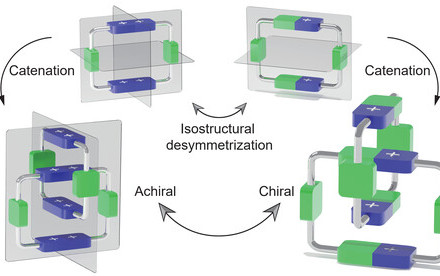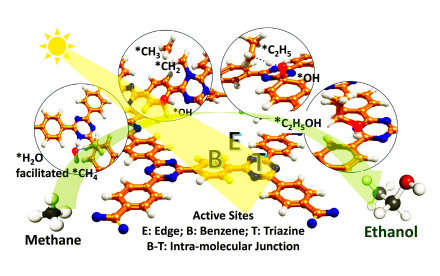29 May 2023
Let the Sun Work its Magic: Revolutionary Sunlight-Powered Catalyst Transforms Methane into Valuable Chemicals
![Selective methane conversion to formaldehyde over a [Vo]-Cu-WO3 photocatalyst. Image adapted from [Nature Communications, 2023, 14, 2690].](/f/news/8222/940p0/Guo.jpg)
Selective methane conversion to formaldehyde over a [Vo]-Cu-WO3 photocatalyst. Image adapted from [Nature Communications, 2023, 14, 2690].
In a concerted effort with collaborators from the University College London, Professor Zhengxiao GUO from the Department of Chemistry, The University of Hong Kong (HKU), and Professor Junwang TANG, now at the Department of Chemical Engineering, Tsinghua University, have jointly developed a highly active and selective catalytic material that can efficiently convert methane, a potent greenhouse gas, into formaldehyde, an essential chemical in a waste-free manner.
This innovative material, derived from tungsten trioxide (WO3 catalyst), features a dual active site comprising copper and tungsten atomic species that work in tandem to ensure an effective and selective conversion process. The conversion process can achieve nearly 100% selectivity under visible light, which avoids unwanted byproducts and increase efficiency, making it an eco-friendly alternative to current production methods. The findings have just been published in the prestigious journal Nature Communications.
Change the unchanged: methane conversion
Methane, the principal component of natural gas, is a widely used carbon source for numerous chemicals. Nevertheless, it is also a potent greenhouse gas, with more than 70 times the global warming potential of carbon dioxide. The catalytic conversion of methane (converting methane into other chemicals), therefore, presents a tremendous opportunity for achieving net-zero energy and chemical supplies while simultaneously addressing environmental concerns. However, methane is an extremely stable molecule, making it resistant to activation, particularly under mild or ambient conditions. Thus, achieving high activity and selectivity in methane conversion is a significant challenge, and the selective activation of the intermolecular carbon-hydrogen bond is often considered by many chemists as one of the most elusive ‘holy grails’ in catalysis.
Formaldehyde, on the other hand, is a high-volume commodity chemical with a market value of USD 8 billion, expanding at a compound annual growth rate (CAGR) of 5.7%. It is used in household, commercial, aviation, medical and automotive products and serves as a valuable precursor for melamine, urea-formaldehyde and phenolic resins, among others. Formaldehyde is also safely used in the manufacture of vaccines, anti-infective drugs and hard-gel capsules. Currently, it is produced through methanol oxidation-dehydrogenation using silver or metal-oxide catalysts at high reactor temperatures of over 500-600°C, resulting in substantial carbon dioxide emissions and energy penalties.
Harnessing Sunlight to Convert Methane
In their study, the team discovers a new way of turning methane gas into formaldehyde using sunlight. They found that a mixture of atomically dispersed copper and partially reduced tungsten species over tungsten oxide worked really well – the synergistic ensemble enabling exceptional photocatalytic methane conversion to formaldehyde under ambient visible light. The process exhibited nearly 100% selectivity and high conversion efficiency, significantly outperforming previously reported photocatalysts (with a turnover frequency, TOF = 8.5×106 μmol (HCHO)·g-1(cocatalyst)·h-1).
Through mechanistic analysis, they figured out that the copper helped to move electrons around and create reactive molecular species while the tungsten helped to activate the methane gas. Specifically, the copper acted as electron acceptors and promoted photo-induced electron transfer from the conduction band to dioxygen, generating reactive hydroperoxyl radicals (HOO·). Meanwhile, the adjacent tungsten atom that had a partial positive charge functioned as hole acceptors. The preferred adsorption and activation site of water produced hydroxyl radicals and effectively activated methane to methyl radicals. The synergy of the adjacent dual active sites greatly enhances the overall efficiency and selectivity of the conversion process.
This finding paves the way for further research and development of new photo-catalysts for a variety of chemical conversions, promoting more sustainable and efficient processes in the chemical industry.
‘Solar conversion of methane is highly desirable for both low-carbon and high-value-added chemical syntheses. However, product selectivity and production efficiency are key to success. This requires an in-depth understanding of the conversion mechanism, careful design of the catalyst, and complementary techniques to confirm its performance – a good case of multidisciplinary tasks that require strong collaborative dedication. That’s exactly what the team has managed to do - with much value-added outcome!’ remarked Professor Zhengxiao GUO, one of the corresponding authors of the paper.
Journal title: ‘Nearly 100% selective and visible-light-driven methane conversion to formaldehyde via. single-atom Cu and Wδ+’ (Nature Communications, 2023)
The journal paper can be found in here.







